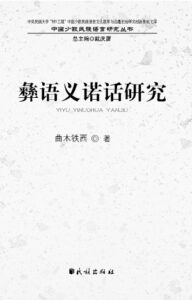
Qumu Tiexi 曲木铁西
Beijing: Min zu chu ban she, 2010
Reviewed by ZHOU Tingsheng (Ph.D. candidate, Minzu University of China; HYI Visiting Fellow 2015-2016)
This award-winning book highlights semantic analysis of the nomenclature of animals and plants in Yinuo, a Tibeto-Burman language spoken by about 600,000 Yi people in southern Sichuan in southwest China. The theoretical framework is based on componential analysis in the study of meaning, which was first proposed by anthropologists for analyzing kinship terms and then further developed in semantic studies by linguists. The author argues that the Yinuo nomenclature of animals and plants encodes the Yinuo Yi people’s traditional life of nomadic hunting and gathering. This is a monograph in linguistics, but may especially benefit both anthropological linguists whose field sites are in high mountains areas in southwest China and biologists who focus on the nomenclature of animals and plants in the area.
The most attractive point of this book is that it provides detailed and comparable linguistic data for semantic studies of the nomenclature of animals and plants in the languages of the Greater Himalayan Region (GHR). As a native Yinuo speaker, the author learned the native terms for local animals and plants from his parents and other elders. While making full use of his knowledge of the nomenclature, he collected linguistic data through consulting elders and reading ancient Yinuo manuscripts during several field trips to the Yinuo Yi area. The data is illustrated in tables and figures under the framework of componential analysis, which is a theory of semantic studies popular both in Chinese and western linguistics. For example, page 49 presents ten different Yinuo words for naming horses aged one to ten; and page 127 indicates that as many as six different words meaning “horse” have been found in ancient Yinuo manuscripts. The related literature shows a majority of languages in the GHR have cognates meaning “horse” which usually have /m/ as the initial consonant; however, in this research it is observed that, out of the sixteen Yinuo words meaning “horse”, only three have /m/ as the initial consonant, and the remaining thirteen are exceptional cases in the nomenclature of horses in the GHR. Such kinds of linguistic data are of great significance to related studies.
As a whole, this work is organized into five chapters which focus on Yinuo phonology, synchronic analysis of the Yinuo nomenclature of animals and plants, diachronic analysis of the nomenclature, classifiers in counting animals and color terms in describing plants, and the nomenclature of animals and plants in the ancient Yinuo manuscripts. Chapter one is an introduction to the Yinuo phonological system with an emphasis of bilabial semivowels (撮唇音cuō chún yīn and long-stressed syllables (长重音zhǎng zhòng yīn) which are prominent in this language. Chapter two and three explore, respectively in synchronic analysis and diachronic analysis, the semes and sememes in the Yinuo names of 30 species of local animals and 30 varieties of local plants. Chapter four focuses on the etymology of classifiers used in counting animals as well as the cultural significance in various colors of local plants. The last chapter analyzes the semantic components in the names of animals and plants that are found in ancient Yinuo manuscripts kept and transmitted by the Jimu clan.
In general, the contents are well-presented and supportive to the author’s point of view; however, further discussion is needed on the appropriateness of comparing the Yinuo nomenclature of animals and plants with those of the related languages in diachronic analysis in section two of Chapter three. In linguistic analysis, a diachronic approach focuses on the historical evolution of languages. Obviously, the analysis of Yinuo nomenclature of animals and plants in ancient manuscripts belongs to a diachronic approach, but comparative studies of the nomenclatures between relative languages does not fall under this approach. Therefore, it may be better if the diachronic analysis is only based on data selected from ancient Yinuo manuscripts.
Nevertheless, this book is particularly worth reading, because it is not only the first monograph on the Yinuo language, but also a guide to the Yinuo Yi people’s naming and categorization of animals and plants habitable in high mountain areas. The author’s research began in the early 1990s when he was completing his master’s degree; and this book originated from his M.A. thesis. Over the past twenty years, a huge amount of linguistic data has been added and the work has been revised several times, winning a prize in 2013 from the Ministry of Education for outstanding achievement in the social sciences.
